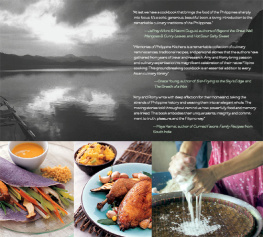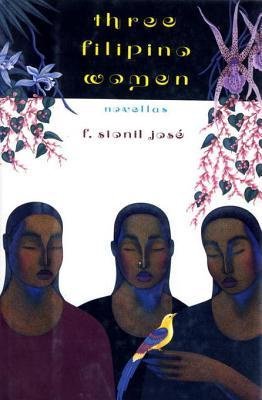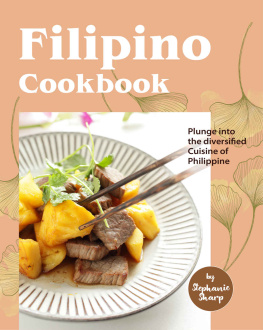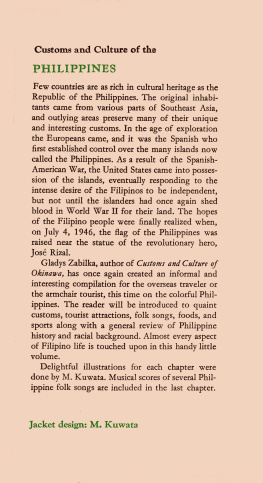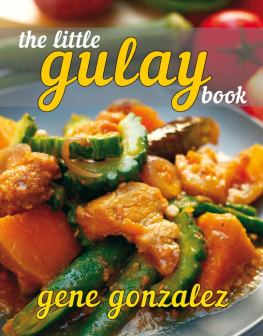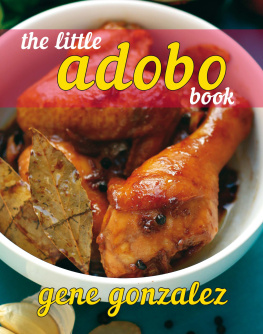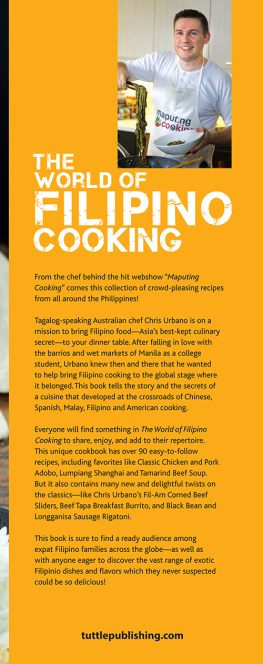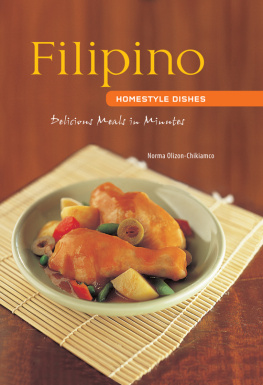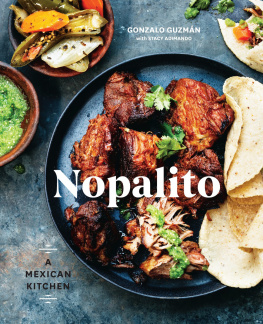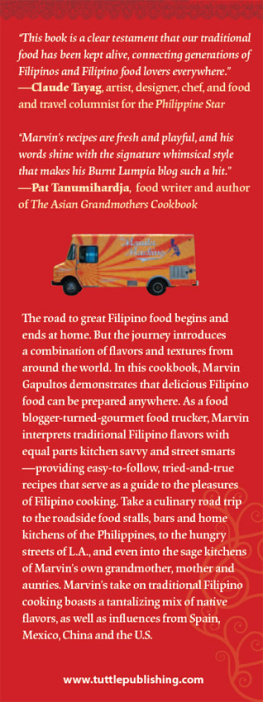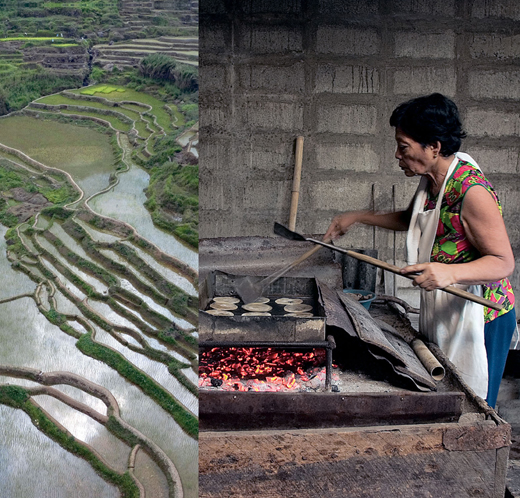
Bicol (left), sago (right).


Sorsogon, Bicol (above left), making piaya in Silay.

Bitter melon.
CONTENTS

Foreword
PETER KAMINSKY
Some people feel at home in the corner bar where, just as soon as they walk in, the bartender knows to pour the usual. Others have a local breakfast joint where the comforting clatter of coffee cups and the smell of sizzling bacon are as familiar as their favorite easy chair.
I have had the restaurants of Romy Dorotan and Amy Besafirst Cendrillon, in trendy SoHo, and now Purple Yam, situated at the epicenter of the Brooklyn dining explosion that has redefined the New York restaurant scene.
I discovered Amy, Romy, and their take on the complex and delightful food of the Philippines shortly after New York magazine made me their Underground Gourmet, which meant I sought out ethnic food and entry-level fine dining. I much preferred the ethnic stuff. In Cendrillon, I found both. I remember crisp soft-shell crab perched atop a salad of bean thread noodles. It was clean tasting, the mark of a chef who could assemble a panoply of tastes without confusing them in a saucy jumble. And a red snapper in a slightly sweet, slightly sour broth, with greens that were unfamiliar but struck just the right balance with the delicate white-fleshed fish. Barbecued pork chops with plum glaze (I am a porkophile, and Cendrillon never disappointed) were served alongside suman, rice cakes steamed in banana leaves topped with a pat of butter and sugar.
And then, the ultimate testmy kids. We went for Sunday brunch and filled up on bibingkaa puddingish cake of eggs with coconut milk, sugar, and feta cheese. If no one had used the phrase comfort food before, it would surely have been invented right then.
I was sold. But I was new on the job, so I called for a second opinion from my friend Bryan Miller, who had been the restaurant critic at the New York Times. Miller gave Cendrillon an enthusiastic thumbs-up. I think his exact words were, This is the real deal.
Equally pleasing to both of ushere was a chef making Asian food and actually pairing it with wine! Who knew? Prior to that I had been of the opinion that in matters Asian, beer was the only way to go, but if you really insisted and just had to drink wine, well, then it had to be a Rhne or a Riesling. But the chef, Romy Dorotan, was pouring light Burgundies and grassy Basque whites, sharp-edged Syrahs, and velvety tempranillos, and they all worked.
Romy was one half of the reason that Cendrillon became my go-to restaurant whenever I wanted something unusual and guaranteed delicious. The other half was his wife and partner, Amy Besa. She filled the front of the house with the bonhomie of a great restaurateur. Like her husband, shes an intellectual who went from Manila to Manhattan when things got a little hot for thinking people with political opinions. New Yorks SoHohip, downtown, everyone dressed in blackwas a perfect fit.
When asked to describe Romys cooking, I often say, Its fusion but coming from the other direction. By that I mean hes not a Western chef who went to Thailand on a cruise and discovered lemongrass. For starters, Filipino food is, by its very nature, fusiona mix of a number of Asian cuisines and, reflecting its colonial past, Spanish with some Mexican thrown in (for nearly three hundred years, the Spaniards ran their colony through the viceroyalty of Acapulco). Add to that Romys experience at one of Manhattans first modern fine-dining restaurantsthe pioneering Huberts. There, he picked up precise French-inspired technique and a willingness to experiment that has kept him in the vanguard of Manhattanmake that Americandining every since.
Then theres Amys unflagging and infectious good cheer, which keeps you smiling through dinner. She is also the self-appointed, and universally acknowledged, den mother of Asian chefs in America. Thai, Cambodian, Filipino, Vietnamese, Indonesian, Keralan, Malaysianwhenever there is an Asian chef doing something new and interesting, Amy is sure to invite him or her to prepare a meal for adventurous diners.
Perhaps the best recommendation I can share with youleast clouded by my obvious love for these unique, accomplished, and lovable restaurateursis the fact that all the food journalists, cookbook writers, chefs, and gourmets I have sent to their restaurants over the years have reported that they had a great meal... and, most convincingly, they all went back.
First it was Cendrillon; now in Ditmas Park, the even more vibrant and innovative Purple Yam. I guess it was inevitable that Romy and Amy would move to Brooklyn. I did, for the peace and quiet and to raise my children. We had plenty of great ethnic food to choose from, but modern, interesting restaurant food? Not so much. But then the crash of 2008 and disenchantment with fussy fine dining sent legions of veterans of the high-priced joints out to Brooklyn to try their luck with its lower rents and hungry foodies. Brooklyn has become the It borough, the place where food energy reaches critical mass. Amy and Romy are right on the crest of the wave. Its good to have them. More bibingka, anyone?
Peter Kaminsky is the author of numerous books on cooking, including Pig Perfect: Encounters with Remarkable Swine and Some Great Ways to Cook Them (2005) and coauthor of Seven Fires: Grilling the Argentine Way (2009). Formerly New York magazines Underground Gourmet, his writing on the subjects of food and angling has also appeared in numerous magazines.

You Can Go Home Again
AMY BESA
In September 2003, I finally found my way home again. I had left Manila thirty years before, a few weeks before marital law was declared on September 21, 1972. Shortly before my departure a fire destroyed the Manila International Airport, and I had to ride a bus to a makeshift terminal to catch my flight. My parents could not ride with me, so I waved at them from the back of the bus, their heads finally disappearing from view as the bus navigated the potholes of Manilas streets. I looked hard at the palm trees, shacks, and people, and said my farewell to a country that had shaped my soul and to a people that had wounded my heart. I was twenty-one years old and felt that my life was ahead of me, but I knew, too, that a part of my life was ending.
I spent a year in Germany as an exchange student, then several years in Philadelphia completing a masters degree in mass communication at Temple University. There I met my future husband, Romy Dorotan, another unsettled student, who was working on his PhD in economics while navigating a never-ending love affair with cooking. It started at the Frog Restaurant, where Romy had been promoted from washing dishes to cooking staff meals.
Next page
